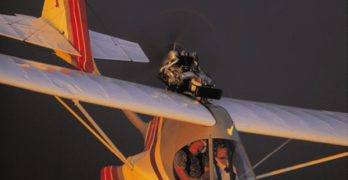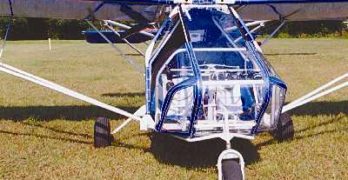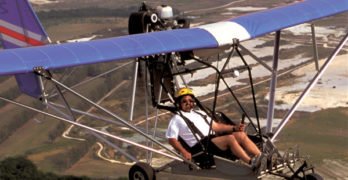In May 2000 I wrote about the imported Sabre Aircraft Venture trike. That model from the Ukraine was quite impressive and worthy of your consideration. Now from the Czech Republic comes the Interplane Skyboy. Should Yankee ultralight manufacturers show concern? Yes, I’d say so. However, American pilots – while perhaps showing an interest in imported designs – don’t seem to buy a lot of these planes. Or do they?
In recent years we’ve seen trike sales soar. Few industry leaders predicted this despite the persistent efforts of the big European trike builders. Many veterans claimed trikes would never have an impact on the majority of pilots who prefer 3-axis controls. They are being proved wrong, for now anyway.
A key reason that holds back U.S. purchases of imported aircraft has to do with local support. Even a good importer can’t always control when spare parts are available. Interplane solves this dilemma in an interesting way and with American style: they bought the Czech Republic factory.
Search Results for : Quicksilver
Not finding exactly what you expected? Try our advanced search option.
Select a manufacturer to go straight to all our content about that manufacturer.
Select an aircraft model to go straight to all our content about that model.
Rans Stinger
The original concept and final design Stinger appear to share only two things. First is the name – S-17 Stinger – and the second is the little bumblebee logo. In every other case I could discern, the finished Stinger is a totally new design from Randy Schlitter’s original idea.
Stinger version two flew for the first time on September 10, 1999. Barely a week later, I found myself aloft in the new ultralight. Normally, I’m not anxious to jump into a manufacturer’s brand-new design. I much prefer waiting until they have the design fully worked out.
However, Randy Schlitter has an excellent reputation for airplanes that seem to fly right off the drawing board (or out of the CAD program these days). He’d put some hours on the Stinger and had given it his blessing. I observed him fly it first and by all measures, it appeared to be ready for evaluation flying.
Golden Circles
As with many ultralight aircraft brands, when single-seaters become dual machines the machine gets heavier and more complicated. And when ultralights get heavier, they often don’t work quite the same.
Since flight school operators and pilots wanting to carry a friend request 2-seat capability, ultralight manufacturers respond, trying to get as close as possible to single-seater feel. But this isn’t simple. Two-seat ultralights often give up some of the qualities that make a single-seater pure joy to fly.
However, designers make constant refinements in ultralights.
Look around at airshows. Most of the ultralights on display these days are well-built machines with lots of custom hardware. Nearly every one got that good employing the CANI approach – Constant And Never-ending Improvement.
Golden Circle’s T-Bird II is one model that has seen subtle but noticeable improvements that make the breed better. Even to those intimate with the Iowa ultralight producer, these changes may evade your inspection.
Flightstar II Sport Cabin
In August 1999,Ultralight Flying! reported on the Flightstar II SL. Thirteen months later, another report is needed as, once again, Tom Peghiny and Spark Lamontagne have upgraded their principal selling model.
Flightstar is the name of the plane and Flightstar Sportplanes is the name of the company, and “refinement” ought to be permanently attached. I’ve followed many ultralights over many years. Some have changed a lot, some have seen almost no change. The Flightstar has almost constantly evolved.
Why change this successful design? After all, it costs money to design, test and build new parts inventories. It takes time and more money to update assembly manuals. Why do all this if the ultralight is doing well? The reason is simple: to make a better product that more people will buy. At least the answer sounds simple; in fact, it may be surprisingly complicated to achieve.
Before we get into how the ultralight flies, let’s review what makes this Flightstar II SC (Sport Cabin) different from the Flightstar II SL (Sport Light).
Phantom
Thousands of other Phantom ultralights are flying, but the one I was about to fly was built by a bunch of kids. Although they were no doubt serious and focused during the building effort, the Phantom X-1 was named Child’s Play. Had I lost my mind?
“So, you’re really going to fly that ultralight built by a bunch of elementary school kids, huh?” The question was more than small talk. The prospect actually worried some observers.
“Of course,” I replied. “The kids probably did a better job than I could.” I’m no builder, a fact I often repeat. After flying airplanes built by all kinds of pilots, I didn’t see the jeopardy in flying the product of students at the Haverhill Elementary School in Portage, Michigan.1
I admit I looked over the Phantom carefully, but I found no flaws. Besides, long-time Phantom pilot and Phantom Aircraft Company president Pat Schultheis had already test-flown it and put hours on it.
Phantom X-1E
What would you do if you produced one of the best known and best loved classic ultralights in the world? If your name is Pat Schultheis and your brand is Phantom, you probably wouldn’t mess with success.
Known simply as Phantom to most folks, the proper name is actually the Phantom X-1. Even this model has gone through refinements over the years. And some builders have further varied the theme; one Phantom I flew had been converted to a taildragger – it was a blast.
A 2-seat Phantom model was tried years ago and newer efforts are underway at this time. The first effort, under the direction of then-Phantom company owner Jack Taylor, flopped so badly that after a short, challenging flight in the machine, I gave it back to the factory and told them I couldn’t report on it yet; it simply wasn’t right and shouldn’t be sold to customers.
Aerotrike
Until recently, we heard little from South Africa. Under the country’s apartheid (racial segregation) rule of the past, South Africa disappeared off the radar so far as most Yankee pilots knew. Our government instituted economic sanctions so that few, if any, South African products appeared in America.
Apartheid is over, and with it the isolation of that southern hemisphere country and its people. In recent years, we’ve seen a growing number of products arrive from the way down under country. Perhaps you’re not surprised to hear that South African ultralight builders are also making a mark on American aviation. Welcome to the modern age of globalization.
No Pushy Peddler
You probably already know of Rob Rollison. He garnered attention in April ’95 by flying his Air-Bike from Indiana to Lakeland, Florida.1 The trip set no records – Ian Coristine, Dave Goulet and Don Zank flew 2-seat Challengers 2,400 miles (round trip) from Moline, Illinois to Lakeland a decade earlier – but in an open-cockpit ultralight, no doubt Rob’s 870-mile (each way) flight seemed longer.
Super Drifter
The original Drifter was one of the ultralight industry’s flagship aircraft. Hatched by early entrepreneur Dennis Franklin, the Maxair Drifter enjoyed immense popularity. Several reasons exist for the Drifter’s popularity, and these were enough for Leza-Lockwood to offer a rebirth to the design.
Déjà Vu All Over Again
The Drifter is a tough design. The basic airframe consists of a lower boom tube that supports the pilot at the front and the large empennage at the rear with an engine midship. Because the separation is longer than some similar designs, the Drifter boasts a high level of stability that should please most pilots.
Secured to the boom by a series of triangulated tubing structures, the wing is classic Klaus Hill. This prolific designer from the early ’80s died in an unfortunate accident many years ago, but not before putting his indelible mark all over ultralight aviation. Klaus is directly responsible for the wings of the Weedhopper, Hummer, Humbug and SuperFloater.
Aeroprakt’s A-20 Vista Cruiser
UPDATE–November 2008: According to FPNA, an American company with a business relationship to A-20 producer Aeroprakt, the A-20 has been discontinued. Please contact FPNA for more information (contact info at end of article).
Two summers ago Americans saw a new aircraft from a Ukrainian company called Aeroprakt as U.S. importer Spectrum Aircraft brought in the A-22 Valor. It would be only the first in a fleet of new microlights.
Later another model from Aeroprakt appeared. In fact, the Vista series comprises 5 models, all variations on a basic theme that is nothing like the Valor. At present, the Ukraine enterprise has no less than nine models including the Valor, Vista, Cruiser, V-STOL, V-SS, Vulcan, Vulcan-SS, Victor single engine, Victor twin, and Viking. Four of this series are twin-engine aircraft, none are alike, and one is a 4-seater. By any measurement, this is quite an accomplishment from a company less than 10 years old and rising from the ashes of the failed Communist empire.
M Squared’s Breese 2
Customers spoke and M-Squared acted. This proves the marketplace works, where customers “vote” with every dollar spent to acquire certain products. More importantly to pilots, this fact explains why a review of M-Squared’s new 2-seater – the Breese 2 – is good for customers.
Customers liked what M-Squared was doing. The 1996 company startup took a popular Quicksilver airframe design, added struts and beefed up the airframe to accept engines as large as the 100-hp Rotax 912S. But pilots also liked the way the original Quicksilvers (which are lighter) flew and handled. Being in business to serve customers, M-Squared acted appropriately.
Paul Mather and M-Squared responded to requests for a lighter version of their 2-seat Sport 1000 in a series of steps. First came the single-surface wing Sprint 1000, which dropped a few pounds by not using the big pod of the first Sport 1000. Then came the Breese SS (single-surface) and Breese DS (double-surface) single-seaters, which were obviously lighter and more agile.











